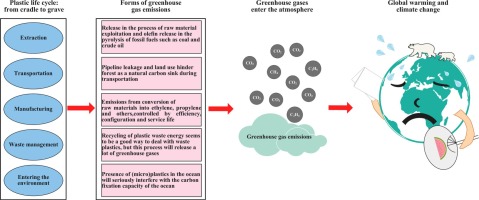Journal of Cleaner Production ( IF 9.7 ) Pub Date : 2020-01-13 , DOI: 10.1016/j.jclepro.2020.120138 Maocai Shen , Wei Huang , Ming Chen , Biao Song , Guangming Zeng , Yaxin Zhang

|
The rapid development of plastic industrials has created a variety of plastic products, causing revolutionary progress in chemistry, physics, biology, and medicine. Large-scale production and applications of plastics increase their possibility of entering the environment. Previous environmental impact studies typically focused on the toxicity, behavior and fate; limited attention was paid on greenhouse gas emissions and climate change. With the increase of plastic waste, the threat of plastic pollution to the earth’s climate has been gradually taken seriously. Evidence showed that greenhouse gas emissions occur at every stage of the plastic life cycle, including extraction and transportation of plastic raw materials, plastic manufacturing, waste treatment and entering the environment. The oil and gas industries used to make plastics are the main sources of greenhouse gas emissions (from the extraction of raw materials to the manufacture of plastics). Emissions of greenhouse gases during manufacture are mainly controlled by the production facilities themselves, usually depending on the efficiency, configuration and service life of equipment. Additionally, there are some unintended impacts, including transport requirements, pipeline leakage, land use, as well as impeding forests as natural carbons sinks. Recycling of plastic waste energy seems to be a good way to deal with waste plastics, but this process will release a lot of greenhouse gases. With this energy conversion occurring, the incineration of plastic packing waste will become one of the main sources of greenhouse gas emissions. Furthermore, plastics released into the environment also slowly release greenhouse gases, and the presence of (micro)plastics in the ocean will seriously interfere with the carbon fixation capacity of the ocean. In its current form, greenhouse gas emissions from cradle to grave of plastics will reach 1.34 gigatons per year by 2030 and 2.8 gigatons per year by 2050. This will seriously consume the global remaining carbon budgets, thereby threatening the ability of the global community to keep global temperatures rising by below 1.5°C even 2°C by 2100. In order to achieve this goal, the total global greenhouse gas emissions must be kept within the remaining carbon budget of 420 – 570 gigatons. The accumulative greenhouse gas emissions from cradle to grave of plastics may exceed 56 gigatons by 2050 (approximately accounting for 10% – 13% of the total remaining carbon budget). As the plastic industry plans to expand production on a large scale, the problem will worsen further. The World Economic Forum forecasted that by 2030, the production and use of plastics will grow at an annual rate of 3.8%, and this growth rate will fall to 3.5% per year from 2030 to 2050. However, there are significant challenges and uncertainties in this estimation, and challenge and uncertainty factors come from all aspects. Recently, several organizations and researchers have started to discern the relationship between greenhouse gas emissions and plastic industrials, but relevant research on these impacts is still in its infancy. Consequently, the contribution of plastic pollution to greenhouse gas emissions and climate change should be given immediate attention and it needs to further explore the impact of plastic pollution on greenhouse gas emission and climate change. The implementation of measures to solve or alleviate the (micro)plastic crisis was critical necessary and proposed: (1) production control of global plastics; (2) improving the treatment and disposal of plastic waste; and (3) assessment of the impact of global environmental (micro)plastics on climate.
中文翻译:

(微型)塑料危机:对全球温室气体排放和气候变化的不可忽视的贡献
塑料工业的快速发展创造了各种各样的塑料产品,在化学,物理,生物学和医学领域引起了革命性的进步。塑料的大规模生产和应用增加了它们进入环境的可能性。以前的环境影响研究通常集中于毒性,行为和命运。对温室气体排放和气候变化的关注有限。随着塑料废料的增加,塑料污染对地球气候的威胁已逐渐得到重视。有证据表明,温室气体排放发生在塑料生命周期的每个阶段,包括塑料原料的提取和运输,塑料制造,废物处理以及进入环境。用于制造塑料的石油和天然气工业是温室气体排放的主要来源(从原材料的提取到塑料的制造)。制造期间的温室气体排放主要由生产设施本身控制,通常取决于设备的效率,配置和使用寿命。此外,还有一些意想不到的影响,包括运输要求,管道泄漏,土地使用以及阻碍森林成为天然碳汇的影响。回收塑料废能源似乎是处理废塑料的好方法,但此过程将释放大量温室气体。随着这种能量转换的发生,塑料包装垃圾的焚化将成为温室气体排放的主要来源之一。此外,被释放到环境中的塑料也会缓慢释放温室气体,并且海洋中(微)塑料的存在将严重干扰海洋的固碳能力。按照目前的形式,从摇篮到塑料坟墓的温室气体排放量到2030年将达到每年1.34吉比特,到2050年将达到每年2.8千兆比特。这将严重消耗全球剩余的碳预算,从而威胁到国际社会的减排能力。全球温度到2100年将上升到1.5°C以下,甚至2°C以下。为了实现这一目标,全球温室气体总排放量必须保持在420至570吉字节的剩余碳预算之内。到2050年,从塑料摇篮到塑料坟墓的累积温室气体排放量可能超过56吉吨(约占剩余碳总预算的10%– 13%)。随着塑料工业计划大规模扩大生产,该问题将进一步恶化。世界经济论坛预测,到2030年,塑料的生产和使用将以每年3.8%的速度增长,从2030年到2050年,该增长率将降至每年3.5%。这种估计以及挑战和不确定性因素来自各个方面。最近,一些组织和研究人员已经开始辨别温室气体排放与塑料工业之间的关系,但是有关这些影响的相关研究仍处于起步阶段。所以,应立即注意塑料污染对温室气体排放和气候变化的贡献,还需要进一步探讨塑料污染对温室气体排放和气候变化的影响。实施解决或减轻(微)塑料危机的措施至关重要,并提出:(1)全球塑料的生产控制;(二)改善塑料垃圾的处理处置;(3)评估全球环境(微)塑料对气候的影响。实施解决或减轻(微)塑料危机的措施至关重要,并提出:(1)全球塑料的生产控制;(二)改善塑料垃圾的处理处置;(3)评估全球环境(微)塑料对气候的影响。实施解决或减轻(微)塑料危机的措施至关重要,并提出:(1)全球塑料的生产控制;(二)改善塑料垃圾的处理处置;(3)评估全球环境(微)塑料对气候的影响。











































 京公网安备 11010802027423号
京公网安备 11010802027423号